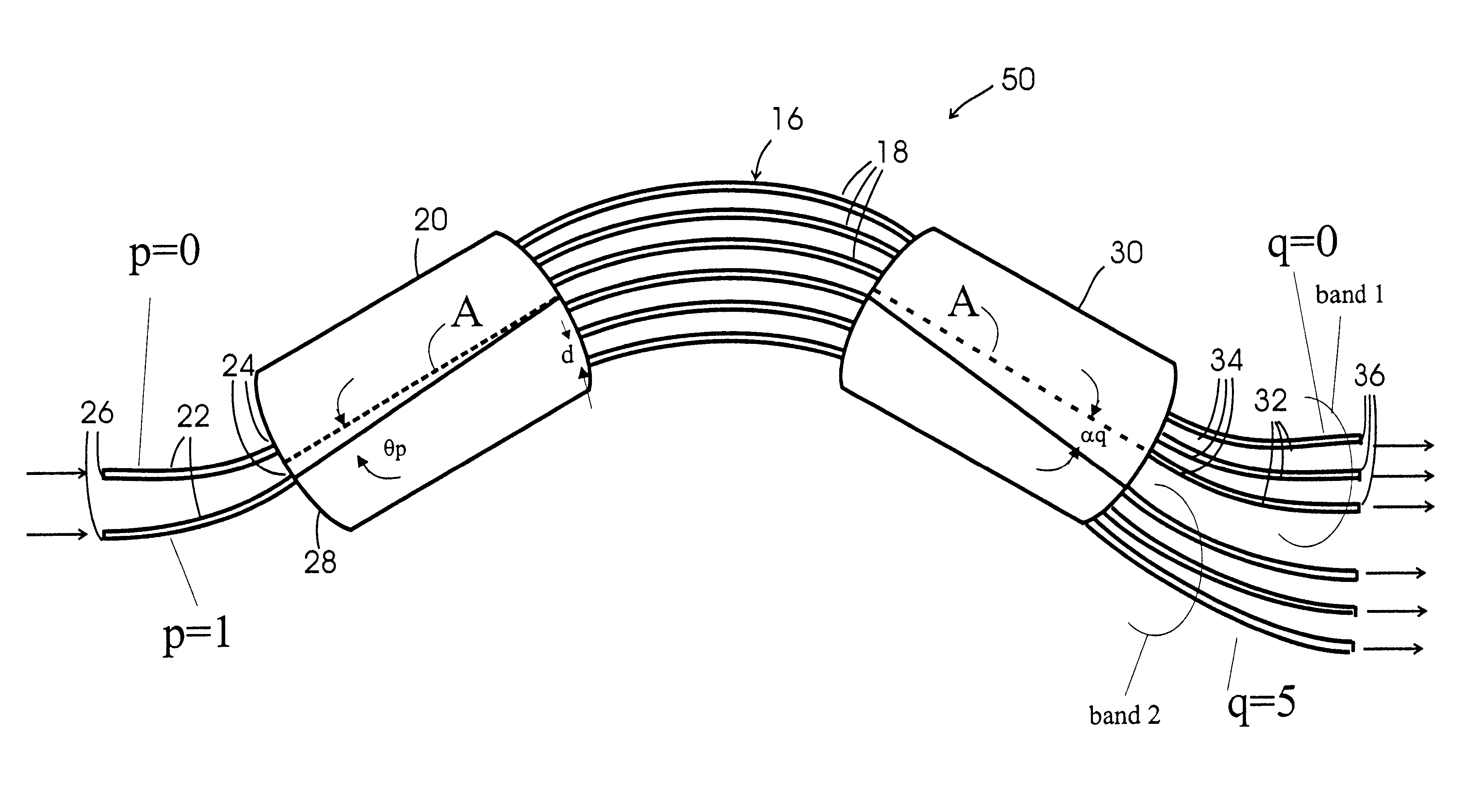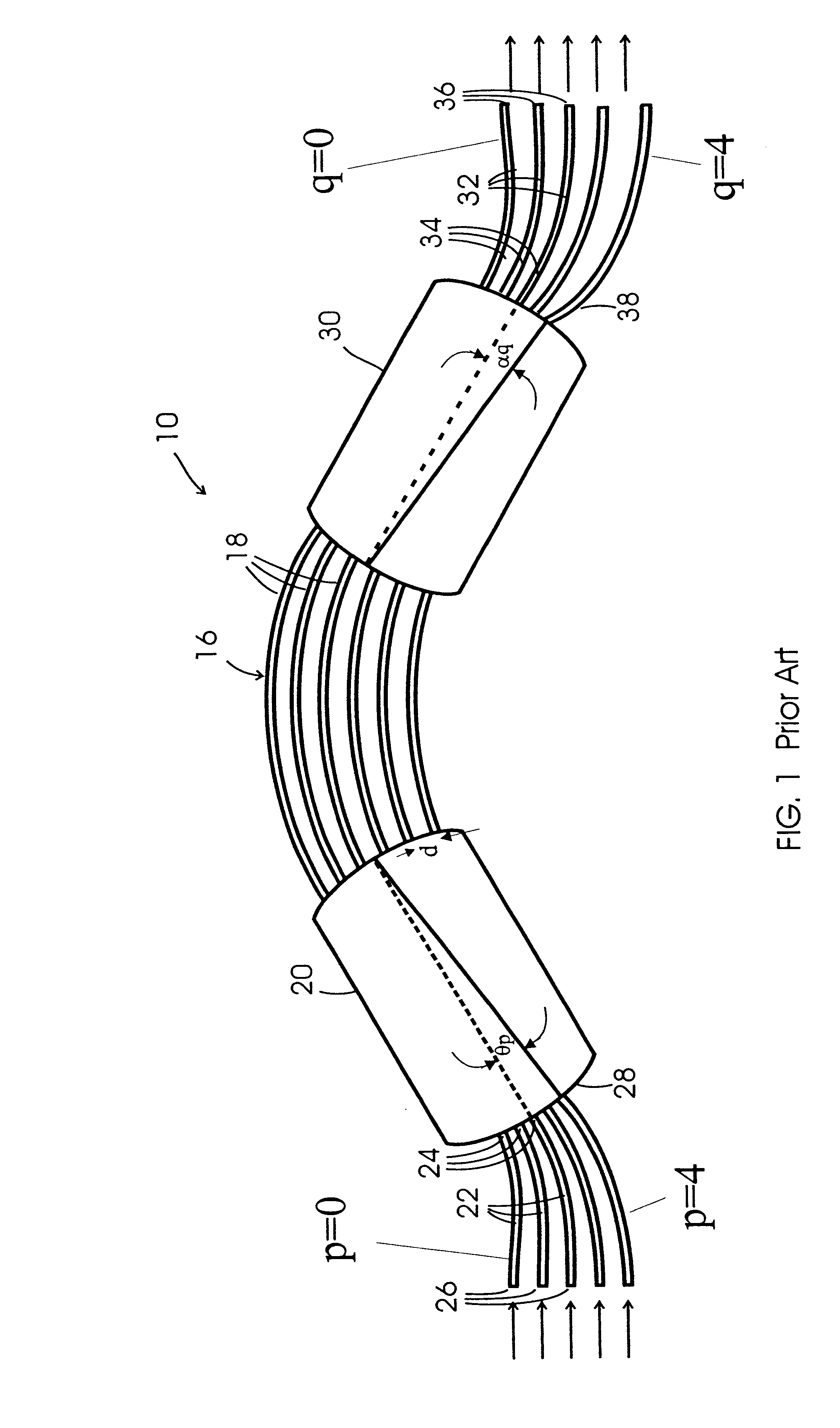Multi-band arrayed waveguide grating
a waveguide and array technology, applied in multiplex communication, instruments, optical elements, etc., can solve the problems of q.times.n awgr modules, reducing yields, and causing the q.times.n awgr modules to be undetectable to manufacture and manage, and the q.times.n awgr modules to be undetectabl
- Summary
- Abstract
- Description
- Claims
- Application Information
AI Technical Summary
Benefits of technology
Problems solved by technology
Method used
Image
Examples
first embodiment
In an AWGR 50 according to the invention, Q.times.N output waveguides 32 are coupled to output slab waveguide 50 at angular locations .alpha..sub.q which satisfy: ##EQU16##
where:
"floor" is the greatest integer function, i.e. its value is the largest integer that is not greater than its argument;
q=0,1,2, . . . (Q N-1);
p=0,1,2, . . . (N-1);
s is a positive integer; and,
e is a number between zero and unity (preferably e is greater than about 0.1).
The plurality of output waveguides is preferably centered at the pole of the output focal curve, which is directly opposite the AWG grating region. That is, preferably:
.alpha..sub.0 +.alpha..sub.QN-1 =0 (18)
N input waveguides are coupled to input slab waveguide 20 at angular locations .theta..sub.p which satisfy: ##EQU17##
Preferably the plurality of input waveguides is centered at the pole of the input focal curve, which is directly opposite the AWG grating region. That is, preferably:
.theta..sub.0 +.theta..sub.N-1 =0 (20)
The AWGR according to ...
second example embodiment
A second embodiment of the invention provides an AWGR 50 having (Q+G-1).times.N output waveguides and G.times.N input waveguides. The output waveguides are coupled to output slab waveguide 30 at angular positions which satisfy: ##EQU24##
The input waveguides are coupled to input slab waveguide 20 at angular positions which satisfy: ##EQU25##
In equations (23) and (24):
q-0,1,2, . . . N(Q+2)-1;
p=floor (q / Q);
g is an integer selected from a predetermined set of integers. In one embodiment g.epsilon.{-1, 0, 1}:
G is the number of members in the set from which g is selected; and,
s.gtoreq.G.
With an AWGR constructed according to equations (23) and (24), the input waveguides are divided into groups with each group of input waveguides associated with a specific value of g. For each value of g there is a target set of output waveguides. The target sets of output waveguides are each divided into N bands with Q passbands within each of the N bands.
FIG. 5A is a block diagram representation of a simp...
third example embodiment
A third embodiment of the invention provides an AWGR 50 having Q.times.N output waveguides 32 coupled to output slab waveguide 30 at angular locations .alpha..sub.q which satisfy: ##EQU26##
N input waveguides are coupled to input slab waveguide 20 at angular positions which satisfy: ##EQU27##
In equations (27) and (28):
c is the speed of light in vacuum; and,
p=floor (q / Q)
As long as p=floor (q / Q) then: ##EQU28##
It can be seen that this embodiment is similar to the first embodiment described above except that the passbands are on a frequency grid rather than a wavelength grid, i.e., the optical frequencies of the passbands are given by:
.nu.=.nu..sub.0 +q.DELTA..nu. (35)
In this embodiment of the invention, when q+2, q+1 and q identify output waveguides within a common band, and n.sub.s is independent of wavelength, the value of R is given approximately by .DELTA..nu. / .nu. which is typically less than 0.001. When one of the output waveguides identified by the indices q+2, q+1 and q is in o...
PUM
 Login to View More
Login to View More Abstract
Description
Claims
Application Information
 Login to View More
Login to View More - R&D
- Intellectual Property
- Life Sciences
- Materials
- Tech Scout
- Unparalleled Data Quality
- Higher Quality Content
- 60% Fewer Hallucinations
Browse by: Latest US Patents, China's latest patents, Technical Efficacy Thesaurus, Application Domain, Technology Topic, Popular Technical Reports.
© 2025 PatSnap. All rights reserved.Legal|Privacy policy|Modern Slavery Act Transparency Statement|Sitemap|About US| Contact US: help@patsnap.com



